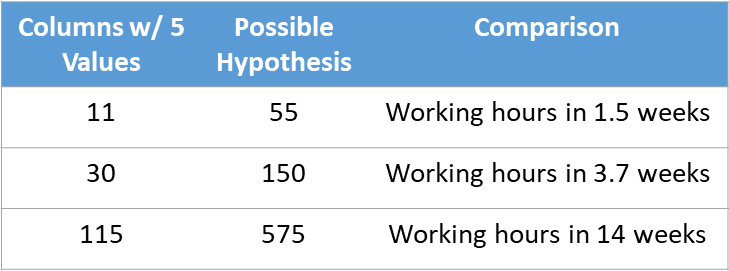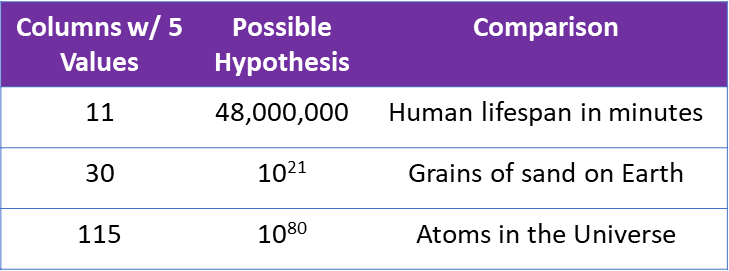Your business is complex. Unsupervised is the first product to make it possible to analyze it’s full complexity.
Your Data is Growing in Complexity, and Traditional Approaches Can’t Keep Up

That process worked very well when we only had a few columns of data. Yet it can’t scale with your data.
If you only wanted to look at very simple patterns in your data, you could just look at single columns on their own. Here is a table that gives you a sense of how many possibilities you would need to review.

Note that this is a good example of where BI has traditionally helped – you could look at a chart of multiple values for one column, letting you get through the 11 column example in only 11 screens

You can see, however, that by 115 columns, even single column analysis starts getting substantial.
Yet the story is far worse when you consider multi-column patterns – patterns that are about several columns having particular values (ex. Customers over 45 in Oregon). You can see that quickly the complexity grows far beyond what people can ever handle.
Traditional Machine Learning Doesn’t Help
Given all you hear online about machine learning and AI, you might expect that there are many solutions to this problem on the market. Unfortunately, popular techniques of machine learning are Supervised Learning techniques. They are intended for problems where the already understood, and you are trying to build a model that will use learnings from what is known about that data to make predictions on new data. This works extraordinarily well for something like identifying whether an image contains a dog vs a cat based on historical examples of such photos, but it does nothing to help you understand your complex enterprise data.
A New Approach
Unsupervised is the first product built from the ground-up to use Unsupervised learning techniques at-scale on diverse enterprise data. Unsupervised learning is the type of machine learning meant for problems where the data is not previously understood – the exact situation businesses find themselves in.
Unsupervised’s platform comprehensively changes your relationship with data.
- Unsupervised connects to your disparate source systems – centralization of data is not required
- Unsupervised handles joining and aggregating sources together. This takes away one of the biggest problems with the traditional analysis – having to plan your exact dataset before you even begin analysis
- Unsupervised can derive new features from your data automatically. Examples would be using Natural Language Processing to extract key phrases in unstructured text fields in your data. This means you don’t have to guess at the features that might matter – Unsupervised tries a huge number
- Unsupervised can explore billions of effective hypothesis across all your enterprise data – exploring possibilities you would never had the time to discover or investigate yourself
- The resulting confirmed hypotheses are presented to you in an easy-to-understand user interface. No math degree is required to understand what the AI has found
All that adds up to a very different workflow.

This process has massive improvements over the traditional approach
- The Business Analyst gets to see what is arising from the data directly – no translation through data scientists, data engineers and data analysts
- You don’t have to keep wondering what you have missed – a far vaster set of possibilities have been explored than people ever could have handled before
- Insights are far richer – because the AI can explore so many hypotheses, it can return results that are far richer and deeper than the old approaches
- All that puts the business first. You spend your time deciding how to act on what is in your data to improve the business, not focused on the data trying to find something relevant to the business.








